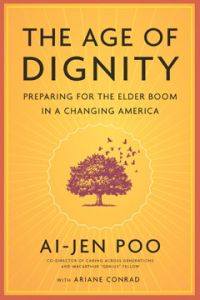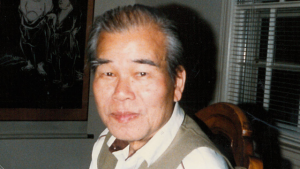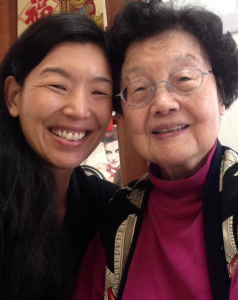The following is an excerpt from Ai-jen Poo’s new book, The Age of Dignity: Preparing for the Elder Boom in a Changing America.
My father’s father, Liang Shao Pu, lived to the age of 93. A lifelong student and then teacher of tai chi and a die-hard Wheel of Fortune fan, he had a slow, deep‑throated laugh that never failed to infect my sister and me, sending us into spasms of giggles. After moving from Taiwan to the United States to be close to his children and grandchildren, my grandfather often picked us up from school, the silhouette of his baseball cap visible from down the block. He was never late.
My grandfather quietly sustained the heartbreaks of my parents’ divorce, the passing of most of his friends and then the loss of his wife of more than 40 years. After my grandmother’s stroke, she could no longer care for herself. With tremendous courage and love, for years he cooked every meal, talked to her and kept her comfortable until the end. One of my greatest regrets in life is that we did not provide him with the same comfort and care in the final moments of his life.
After repeated strokes, my grandfather’s condition had deteriorated to the point that my dad no longer felt capable of providing the support he needed to stay at home and could not find appropriate home care support, so my grandfather was placed in a nursing home, against his wishes. I visited my grandfather there before he passed away.
My grandfather’s bed was along a wall in a large, dark room with six other people, half of whom were completely silent, while the other half expressed their misery in loud, painful cries. The room lights were kept off, while a sickly fluorescent light in the hallway flickered. The place smelled like mold and death. It was my heart‑wrenching introduction to dehumanizing institutional care.
When I arrived at his bedside, my grandfather was distressed. He believed the nursing home staff was trying to poison him. He had not slept or eaten for some time. He was frightened and in pain. He was a shadow of the person I knew growing up. I was furious and devastated.
After three months, he passed away in that facility. I almost feel as though he died the moment he arrived there; his dignity was stripped away upon entry. My father, my sister and I will always regret that my grandfather’s final hours and ultimately his death were so lacking in comfort and beauty. He meant so much to us. I so wish we had been able to keep him at home.
I’m far from alone in my aversion to nursing homes. Nearly 90 percent of Americans feel institutions are not the appropriate place for elders to spend their final moments, months or years. The great majority of us want to live and age at home. The question is how, exactly, we can manage that.
America is about to experience an “elder boom,” a direct result of the baby boom of 1946 to 1964. We have more senior citizens in America today than we’ve had at any time in our history. Every eight seconds an American turns 65; that’s more than 10 thousand people per day, almost four million per year. A century ago, just about 3 percent of the population was 65 or older. Today more than 13 percent of Americans are over 65, and by 2030, the number will be 20 percent. The five million Americans older than 85, our country’s fastest‑growing demographic, will number 11.5 million by 2035. Because of advances in health care and technology, people are living longer than ever, often into their 90s or breaking 100.
Let’s remember: people getting older is not a crisis; it’s a blessing. We’re living longer; the question is how we should live. As a country, we have to figure out how to embrace this demographic shift with grace. Just as the baby boom brought with it incredible power and opportunity, so does the coming elder boom.
One thing we know is that the longer people live, the more likely they are to need assistance. Seventy percent of people aged 65 or older need some form of support. By 2050, the total number of individuals needing long‑term care and personal as‑ sistance is projected to grow from 12 million to 27 million. It is often assumed that women will absorb these tasks, as they have for much of our country’s history, but that is not going to happen in 21st‑century America. Most households today are dual income, which means there is no one at home full‑time; at the same time, more and more American households have both children and aging parents who need support and care every day. The need for professional caregivers is skyrocketing.
Aging at home necessitates home care workers. Yet the three million people currently in the home care workforce cannot meet even the current need, let alone the demand for care that will accompany the elder boom. We will need at least 1.8 million additional home care workers in the next decade. As a result, caregiving, specifically home care, is the fastest growing of all occupations in the nation. By 2018, demand for home care workers will increase by more than 90 percent. Many of the existing eldercare workers are low‑income African-American and immigrant women who are faced with innumerable challenges, among them low wages, long hours and inadequate training. Of the one‑quarter of today’s home care workers who were born outside the United States, about half are undocumented, which means that fear of deportation puts these workers under further stress. These conditions have led to high turnover in the industry, which hurts everyone: elders, their families and the workers themselves.
Many of these issues also have profound implications for people of all ages with disabilities. With the birth of the disability rights movement in the 1960s and 1970s, independent living replaced institutionalization as the clear preference of people with disabilities. Alongside assistive technologies, it is home care workers, predominantly known in the community of people with disabilities as “personal attendants,” who enable many people with disabilities to manage their personal care, maintain a home, have a job, go to school and participate in other aspects of independent living. According to the U.S. Census, in 2000, an estimated 13 million Americans with disabilities were living independently in their communities. The concerns and stories of people with disabilities are and should be the subject of many books, and while these topics are deeply connected, this book’s focus is the aging of America — the challenge and opportunity of this demographic moment.
Many Americans currently struggle to afford the care they need. On average, a home health aide hired through an agency costs approximately $21-per-hour, the cost of an assisted living facility averages $3,300 per month and a semiprivate room in a nursing home costs $6,200 per month. Yet the average Social Security check amounts to just $1,230 per month, and Medicare provides little if any support for home‑based care. How can elders or people with disabilities remain at home and live independently without sufficient support or funding? Our country has not adequately accounted for the caregiving we need. Yet home care is the future.
By 2010, we at the National Domestic Workers Alliance, an organization I helped found in 2007 to support the nearly invisible workforce employed inside homes across America, began hearing more and more workers asking for training in eldercare. Although these workers had been hired as nannies and housekeepers, they were now being called upon to provide home care for their employers’ aging parents, too.
In response, in 2011, together with our sister organization Jobs with Justice, we launched Caring Across Generations, an initiative that addresses two of the major social issues of our time: widespread unemployment and the coming need for care for the nation’s expanding aging population. At the same time that millions of people in the United States are struggling to survive long‑term unemployment, there are far too few workers who are positioned and prepared to provide care for the growing number of elders and people with disabilities. The demographic shift creates a moment when we can set in place a system to affirm the dignity of people at every stage of life and in every walk of life, and create millions of good jobs in the process.
Caring Across Generations, led jointly by 20 organizations representing caregivers, care consumers and their families, is a national movement to embrace our changing demographics, particularly the aging of America, and an opportunity to strengthen our intergenerational and caregiving relationships. We’re calling for an innovative approach to care, rooted in our homes and communities, that brings us all together and offers support to everyone involved.
As for Me
As a young person, I saw women as key to everything working well, yet our systems were not working for women. So I joined my first women’s organization in high school and have not looked back since. No question: my dedication to women was inspired by my mother and my mother’s mother — the brilliant, strong, beautiful women who cared for me. They were innovators and trailblazers, yet so much of their work seemed to go unnoticed and unappreciated. They sacrificed so much, even their own health at times, to work and to care for us, the way so many women and family caregivers do. Today I witness the domestic workers in my organization caring for the families they work for and, after a long day, returning home to care for their own families, surviving with less support and fewer resources than my mother had. Working women of all walks of life face impossible choices. I hear and collect their stories everywhere I go; you will find many in the pages of this book. They help expand my sense of what ‘s possible, and they have helped me through my own difficult choices.
“Well, you should have stopped traveling.” That’s the first thing a friend of mine said to me after my miscarriage. Like millions of other women in America and around the world, I’ve been through the quiet, enigmatic labyrinth of fertility treatments and all the heartache associated with the process. I know the impossible choices women face while deciding which work trips to cancel in preparation for fertility treatments, the desperate searches for medical laboratories while traveling, the sleepless nights filled with guilt, self‑doubt and shame that come along with making a choice — whatever it is.
And I know what it means to need to focus on one area of care and not have a whole lot left for anything or anyone else. At every stage of my struggle with fertility, my mom always told me, “We’ll be okay.” What if she wasn’t okay? What if she needed me? What if I had to travel for her? I never stop feeling the need to prepare for that moment and what it would mean for my ability to care across generations, in both directions.
Almost all our major laws and systems for care are based on standards and demographics from another era. However, today, from what I see all over the country and in many places across the globe, we ‘re finally moving from impossible, false choices to real choices. People are already adapting. In their experiences and stories, many of which I’ve tried to include in this book, we can see the future we need to create. We can see the way we need to adapt the system.
With some course corrections in our culture and in our institutions, we can have the care infrastructure that will enable us to live our full potential. We’ve adapted many systems before, changing our country for the next era, and while it’s never going to be easy to be the mom, partner, or daughter that you want to be, at least the very material and practical elements of that complexity can be relieved by a solid, reliable care infrastructure.
This is a book of problems finding solutions. When they do, it will give us all real choices — no matter who we are or what role we play at any given time — choices that enable us to be free, to love, to have peace of mind. The moral of this story is that a caring America is entirely within reach.
Care is something we do; it’s something we want; it’s something we can improve. But more than anything, it’s the solution to the personal and economic challenges we face in this country. It doesn’t just heal or comfort people individually; it really is going to save us all.
Copyright 2015 by Ai-jen Poo. This excerpt originally appeared in The Age of Dignity: Preparing for the Elder Boom in a Changing America, published by The New Press. Reprinted here with permission.






